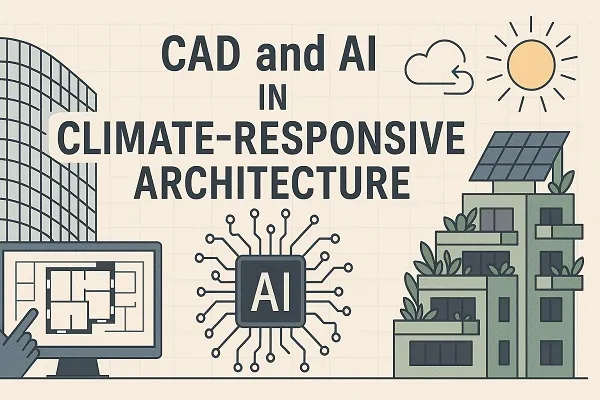CAD and AI in climate-responsive architecture are reshaping how architects design, simulate, and optimize buildings to interact harmoniously with their environment. This integration of computer-aided design tools and artificial intelligence allows architects to create spaces that adapt intelligently to climate variations, reduce energy consumption, and promote sustainable living.
Intelligent Integration of Technology and Climate Design
Climate-responsive architecture has always aimed to design buildings that naturally adjust to their surrounding environment. With advanced CAD systems and AI algorithms, architects can now analyze data sets that include solar radiation, wind patterns, humidity levels, and thermal performance before construction even begins.
AI tools process this data through predictive modeling, helping designers test multiple design variations quickly. CAD platforms equipped with AI-assisted modeling can:
- Optimize building orientation for passive solar heating and cooling
- Suggest ideal material combinations for thermal comfort
- Generate adaptive facades that respond to temperature or light
- Simulate energy efficiency performance across various climate scenarios
This integration ensures that buildings are not just visually innovative but also environmentally responsive.
Data-Driven Design Optimization
Modern CAD software enhanced by AI transforms design from intuition-driven to data-driven. Instead of relying solely on experience, architects can evaluate real-time environmental data within their design workflows.
Key Advantages of Data-Driven Climate Design
- Precision Modeling: AI-driven CAD tools refine design accuracy by simulating how a building behaves under diverse climate conditions.
- Energy Efficiency Insights: Predictive analysis allows designers to measure how insulation, shading, and orientation impact energy usage.
- Performance-Based Design: Instead of drawing static blueprints, architects create responsive models that adjust based on data feedback.
- Reduced Iterations: AI automation minimizes the time spent on manual revisions, streamlining the entire process.
This method not only shortens design timelines but also enhances sustainability metrics through consistent testing and feedback loops.
Adaptive Facade Systems and Smart Materials
Climate-responsive architecture increasingly relies on adaptive building envelopes. AI-integrated CAD systems help model facades that automatically regulate airflow, shading, and heat transfer.
Architects use AI to:
- Evaluate solar angles throughout the year
- Design facade geometries that balance daylight and glare
- Integrate materials with dynamic properties such as phase-change composites or electrochromic glass
By linking AI simulations with CAD geometry, these systems can “learn” and adjust designs for each region’s specific climate characteristics, achieving balance between comfort and energy efficiency.
AI-Assisted Environmental Simulation in CAD

Environmental simulation is at the core of climate-responsive design. With CAD and AI integration, simulations now extend beyond simple thermal models into predictive climate analytics.
Applications of AI in Environmental Simulation
- Wind Flow Analysis: Machine learning models predict wind behavior around structures to improve ventilation and reduce turbulence.
- Daylight Optimization: AI calculates how sunlight moves across spaces to ensure optimal natural lighting.
- Thermal Comfort Mapping: Predictive analytics assess how materials retain or dissipate heat.
- Water Management: AI aids in designing rainwater harvesting and drainage systems based on local rainfall patterns.
The result is architecture that anticipates environmental challenges rather than reacting to them.
Generative Design for Climate-Responsive Architecture
Generative design powered by AI has become a game-changer within CAD environments. It allows architects to set performance goals related to climate, energy, and comfort—and then automatically generate design options that meet those objectives.
Benefits of Generative Design
- Creates multiple optimized design alternatives in minutes
- Balances environmental factors with aesthetic and structural requirements
- Encourages experimentation without sacrificing performance data
- Reduces human bias in early design decisions
This approach expands the creative potential while maintaining measurable sustainability targets, aligning perfectly with the principles of climate-responsive architecture.
Energy Modeling and Performance Monitoring

Energy modeling within CAD platforms, enhanced by AI, provides continuous insight into a building’s predicted performance throughout its life cycle. AI algorithms analyze material efficiency, HVAC loads, and occupancy patterns to forecast real-world outcomes.
Typical AI Applications in Energy Modeling
- Simulating cooling and heating demands across seasonal changes
- Predicting solar gains to reduce artificial lighting dependence
- Estimating carbon footprint and life cycle energy use
- Suggesting retrofit strategies for existing structures
By integrating energy modeling early in the CAD workflow, architects ensure that sustainability is embedded at the concept stage, not added later as an afterthought.
Automation in Sustainable Urban Design
Climate-responsive design extends beyond individual buildings to entire communities. AI-powered CAD platforms support urban planners in modeling green cities that adapt to local climates.
AI tools assist in:
- Planning optimal street orientations for wind and shade
- Analyzing vegetation patterns for cooling effects
- Locating water-efficient landscaping zones
- Creating transportation systems that minimize carbon emissions
This systemic approach aligns with the global push toward sustainable urbanization and smart cities.
Collaborative Design Ecosystems
Cloud-based CAD platforms integrated with AI create collaborative ecosystems where architects, engineers, and environmental specialists can share data in real time. This collaboration ensures every stakeholder contributes to climate-sensitive solutions.
Shared AI dashboards visualize real-time simulation results, helping teams make faster, data-backed decisions. The feedback from each design iteration improves the accuracy of subsequent simulations, fostering a learning loop that enhances both creativity and precision.
Material Intelligence and Lifecycle Optimization

AI integration allows CAD tools to suggest materials not only based on aesthetics or cost but on environmental impact. Architects can evaluate lifecycle energy use, recyclability, and regional availability.
Sustainable Material Selection Benefits
- Reduces embodied carbon by using locally sourced options
- Enhances thermal comfort through AI-assisted insulation modeling
- Supports circular design principles through recyclability data
- Improves maintenance predictions via performance tracking
Material intelligence transforms construction from resource-intensive to regenerative design practice.
Buildings designed through CAD and AI in climate-responsive architecture stand as evidence that technology and sustainability can coexist with elegance and efficiency. By combining analytical precision with creative vision, architects can design structures that breathe with their environment, reduce ecological impact, and deliver human comfort through intelligent adaptation.
Content reviewed and published by Tier2Tek Staffing Editorial Team .

